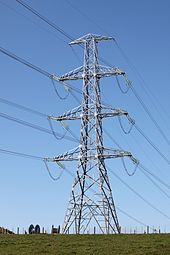This article needs additional citations for verification. (May 2010) |

A dead-end tower (also anchor tower, anchor pylon)[1] is a fully self-supporting structure used in construction of overhead power lines. A dead-end transmission tower uses horizontal strain insulators at the end of conductors. Dead-end towers may be used at a substation as a transition to a "slack span" entering the equipment, when the circuit changes to a buried cable, when a transmission line changes direction by more than a few degrees, or at intervals along a straight run to limit the extent of a catastrophic collapse.

Since dead-end towers require more material and are heavier and costlier than suspension towers, it is uneconomic to build a line with only self-supporting structures.[2]
Dead-end towers are used at regular intervals in a long transmission line to limit the cascading tower failures that might occur after a conductor failure. An in-line dead-end tower will have two sets of strain insulators supporting the lines in either direction, with the lines connected by a jumper between the two segments. Dead-end towers can resist unbalanced forces due to line weight and tension, contrasted with suspension towers which mostly just support the conductor weight and have relatively low capacity for unbalanced load. Dead-end towers may use earth anchor cables to compensate for the asymmetric attachment of the conductors. They are often used when the power line must cross a large gap, such as a railway line, river, or valley.
Dead-end towers may be constructed of the same materials as other structures of the line. They may be steel or aluminum lattice structures, tubular steel, concrete, or wood poles.
- ^ Edwin Le Roy Gemmill (1920). Transmission towers. Blaw-Knox. p. 48. Retrieved 2010-05-15.
anchor transmission tower.
- ^ D.G. Fink, H.W. Beaty, Standard Handbook for Electrical Engineers Eleventh Edition, McGraw-Hill, 1978 ISBN 0-07-020974-X, pp. 14-80, 14-81